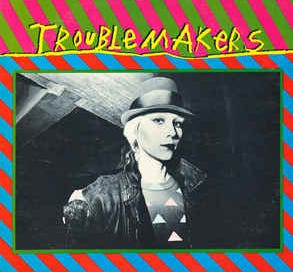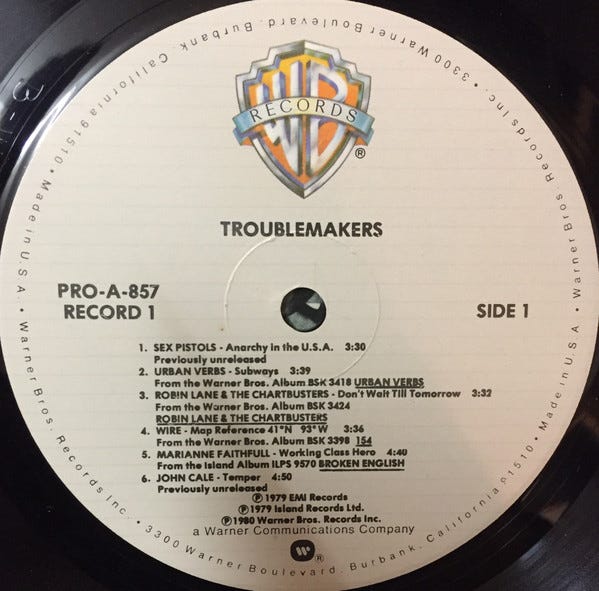A while back I started writing about Warner Brothers' Loss Leader record samplers, a series of 2LP vinyl records that compiled tracks from Warner Brothers and its sister labels' formidable roster of talent. I wrote about The Big Ball, a 1970 release by the label. As I continue to collect and write about this series, I'll try to capture the year and the varying fortunes of Warner Records and the music business that can be gleaned from the collections. Mostly I try to ferret out the best music and bring attention back to bands that didn't make it big or maybe had a short time in the spotlight. Today I turn my attention to the compilation that was released in 1980 (the second such compilation in that year) called Troublemakers. It turned out to be the last release in the original Loss Leader series.
The 1970s at Warner Brothers Records is sometimes referred to as 'The Ostin Era.' This was the time period when the label’s executives, AR men, and staff producers included Mo Ostin, David Geffen, Joe Smith, Stan Cornyn, Lenny Waronker, Andy Wickham, Russ Titelman, and Ted Templeman. The label was known as an 'artist first' enterprise and had no problem attracting much of the bestselling rock talent of the day.
In the last few years of the decade, a new rock style became influential and achieved popularity as well, at least for certain acts. The label invested in the new sounds, signing Devo and the B-52s. They also bought Sire Records in 1978, retaining label head Seymour Stein as president. Stein had signed a number of punk and new wave bands, including Dead Boys, The Ramones, Talking Heads, as well as a new dance club sensation, Madonna. Stein also had distribution deals with a number of British indie labels who were releasing cutting edge music that would be defined as post-punk. This brought bands such as Gang of Four, Public Image Ltd., Yaz, and Depeche Mode, into the label's orbit.
Warner continued to feature some of these bands on its Loss Leader series, part of the usual potpourri of musical material they presented twice yearly in the form of double LP samplers that anyone could order for only a few dollars to cover shipping costs. For their second release in 1980, the label did something unusual, but smart. They featured a group of their current new wave and postpunk bands exclusively on the Loss Leader release Troublemakers.
The idea of the type of compilations that the Loss Leader series represented had seemed like a vital marketing tool in the late 1960s and the early '70s when people still found out about new music a lot by word of mouth. By the mid-70s, people found out about new music largely through the intensive efforts of the record labels. As rock music grew into a massive business sector, the marketing departments of major record labels grew into small fiefdoms.
In the self-proclaimed 'obituary of rock and roll' The Boy Looked At Johnny, Julie Burchill and Tony Parsons describe the relationship between New York's punk scene and Warner's Sire label:
"And even if a band makes it onto the stage, they then have to survive the savage scrutiny of influential media magnates Richard Robinson (record producer/rock writer) and his sly spouse Lisa Robinson (syndicated scribe/socialite scene manipulator)--the only NYC hacks who call the tune when it comes to the submission of well-worn wares.
Seymour and his business (but not sleeping) partner-wife Linda control investment of capital, Richard and Lisa control media marketing, and the fun foursome share a collective court jester in senile whizz-kid Danny Fields, ex-hired hand of Lou Reed, the Stooges, and The Doors."
The Boy Looked at Johnny: The Obituary of Rock and Roll, Julie Burchill and Tony Parsons, 1987 (First American Edition), Faber and Faber. (pg 57).
Punk and postpunk bands were largely discovered and shared, initially, by word of mouth of fans and local publications, particularly zines. Someone had the brilliant idea of dedicating the record to featuring the label's new wave catalog exclusively, giving it a musical sound, an identity based on the music included. On previous Loss Leader samplers, the unifying concept was that the bands were all Warner Bros. artists. That's not the only unifying concept of Troublemakers.
One of the good things about creating a Loss Leader with a certain aesthetic concept is that it limits the bands that the label featured on the sampler, so we get to hear more than one track from Urban Verbs, Robin Lane & the Chartbusters, Wire, Public Image Ltd., the Buggles, Pearl Harbor & the Explosions, and Gang of Four. I've always especially enjoyed compilations that have two or three songs per artist, and I used to sometimes create mixtapes that way.
Urban Verbs were the darlings of the DC punk scene, and they drew the attention of Brian Eno, who recorded and remixed two of their songs, which the group used as a demo. Of course, the band had an in: Verbs' lead singer Roddy Frantz was the brother of Talking Heads drummer Chris Frantz, and Eno produced several Talking Heads albums. Signed to Warner, the Verbs made two excellent albums: Urban Verbs (1980) and Early Damage (1981), but neither sold well and Warner dropped the band. It's a shame because guitarist Robert Goldstein (who passed away in 2016) creates perpetually interesting soundscapes and the band definitely had their own sound. Calling them "Fascinating but tragically overlooked" Trouser Press' Ira Robbins maintains that "while guitarist Robert Goldstein guided the band through striking modern instrumental pieces of depth and quality, Roddy Frantz’s urban-alienation lyrics, delivered in a fair approximation of David Byrne’s vocal style, typecast the group as second-string imitators. The Verbs’ records showed great potential, but this needless flaw prevented them from being taken seriously."
They are represented on Troublemakers by two tracks from their first album: "Subways" ('I leave my problems on the street/and ride the subway where it's always warm) and "The Only One of You," which, while quirky, is the poppier song. The Urban Verbs also distinguished themselves by using synthesizers at a time when most punk bands were just using an organ or electric piano.
Robin Lane began singing in folk-rock clubs in California in her late teens, and in 1969 she became known when she sang on "Round and Round," a track from Neil Young's Everyone Knows This Is Nowhere. In the ‘70s she moved to Cambridge, MA, and became interested in the harder rock sounds of some of the punk bands on the East Coast. In 1978 she formed the Chartbusters featuring Asa Brebner and Leroy Radcliffe (both from The Modern Lovers) Scott Baerenwald and Tim Jackson. The group played energetic rock that was heavily influenced, both in topic and in performance, by Lane's folk-rock roots and her Christian faith. This was another hugely underrated band whose music should have been blaring from every car radio, and its Byrds update proved influential on bands like The Bangles. The two tracks here, "Don't Wait Till Tomorrow" and "Kathy Lee" come from the band's first album on Warner, but the followups, Imitation Life and the EP Five Live, are also great and deserving of being sought out. In 2019 Blixa Sounds released Many Years Ago, a complete collection of Lane's Warner output with a nice package, so her best work is accessible right now.
Wire is the most process and experiment-focused band here and in that respect, I would compare them to Radiohead. Wire retains a talent for pop music but approaches it obtusely from a minimalist angle. Both tracks on Troublemakers come from the group's third album, 154. It would be their last for eight years until the group resurfaced with a more electronic sound in 1987. Even so, the group developed quickly over the course of their first three Warner releases: While Pink Flag was minimalist punk, Chairs Missing added keyboards and more expansive song structures. 154, named for the number of live gigs that Wire had played up to that point, consolidated what the group had learned and taken from the differing approaches to the first two albums. The beautiful “Map Ref. 41°N 93°W” manages to evoke Joy Division, R.E.M., and Pylon during its 3:40 duration.
This concludes Part I of this newsletter article. Part II will publish on Tuesday, November 17th.
Bonus Tracks
Running November 6 thru December 11, ‘Sites & Sounds from Big Ears’ hosts the Norwegian Digital Jazz Festival, a 15-act series highlighting many of the most compelling artists from that nation’s fertile musical scene. Big Ears is teaming up with Musikkprofil Booking & Management, Oslo’s Sentralen performing arts center, and Hes & Falck to present the series which launches on Friday, November 6, and spans five weeks of programming. The festival offers a multi-faceted portrait of Norway's unique jazz scene, over seven double-bill concerts, featuring artists including pianist Bugge Wesseltoft, saxophonist Tryvge Seim, guitarist Eiven Aarset, and trumpeters Mathias Eick and Nils Petter Molvær, plus an evening with pianist Tord Gustavsen — as well as many other essential Norwegian jazz artists. Each performance has been elegantly filmed on-site at the Sentralen in Oslo, Norway.
Baron Wolman, the first staff photographer for Rolling Stone magazine, passed away this week at the age of 83. Wolman created iconic images of artists like Bob Dylan, Jimi Hendrix, The Who, Joni Mitchell, and many others who defined the classic rock era. He was the chief photographer at Rolling Stone from 1967 through 1970, when he left to start an alternative fashion magazine, Rags, that folded after thirteen issues. In 2011 he published the retrospective book Every Picture Tells a Story: The Rolling Stone Years.
NDIM website published the latest in our In Ten Tracks Series dedicated to favorite songs that tell the story of a band or that have remained personal favorites through the years. This time. I look at the music of NYC band Blondie.
Quotable Jazz is a one-of-a-kind reference that’s as essential to your jazz collection as Giant Steps or Kind of Blue. Now, for the first time, it is available as a Kindle book. If you are a Kindle Unlimited member, you can read it for free.
Like the Velvet Underground, you might find that Pylon is your favorite band's favorite band. With a gorgeous box set featuring new vinyl pressings of their two complete albums, Pylon is ready to talk about why their music still influences and resonates after all these years. One more reason that Georgia is back in the spotlight.
Leaving you this week with Jamie Cullum doing "The Wind Cries Mary" from the 2004 Newport Jazz Festival
Wishing you a good day and I'll see you next week.




